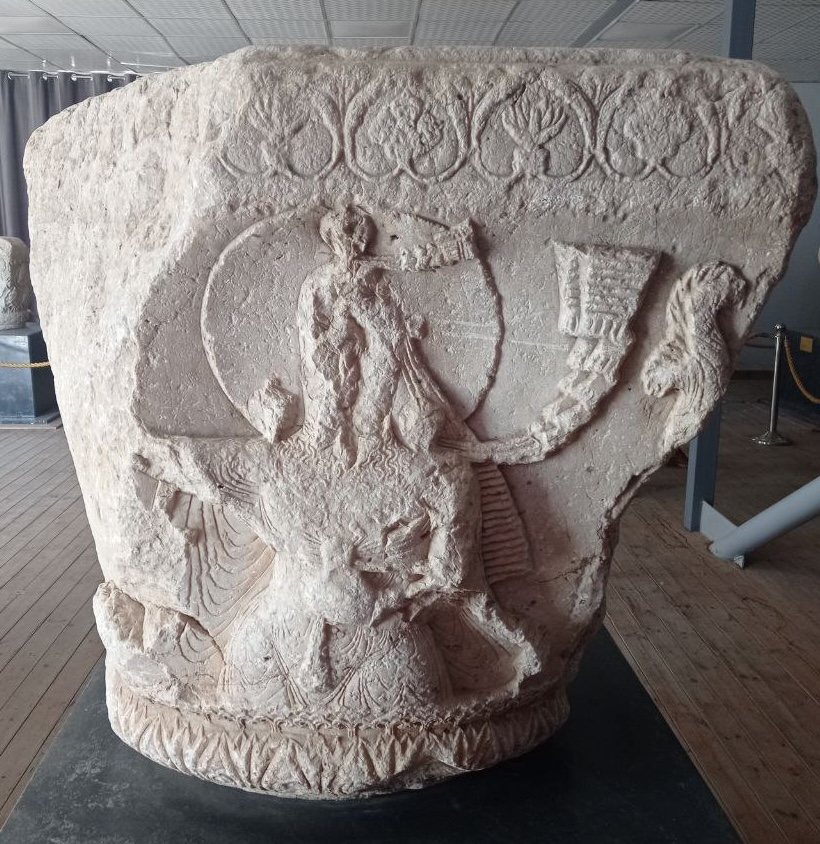Thread: The boat journey of the god Enki (cylinder seal impression, ca. 2300–2150 BCE). Source: W. H. Ward, The Seal Cylinders of Western Asia...
There is a very strange part in the Mesopotamian poem called "Gilgameš, Enkidu and the nether world" (etcsl.orinst.ox.ac.uk/cgi-bin/etcsl.…)...
There is a very strange part in the Mesopotamian poem called "Gilgameš, Enkidu and the nether world" (etcsl.orinst.ox.ac.uk/cgi-bin/etcsl.…)...

It goes like this:
"...When he set sail...when Enki set sail for the nether world, against the lord a storm...arose...The waves at the bow of the boat rose to devour the lord like wolves and the waves at the stern of the boat were attacking Enki like a lion..."
"...When he set sail...when Enki set sail for the nether world, against the lord a storm...arose...The waves at the bow of the boat rose to devour the lord like wolves and the waves at the stern of the boat were attacking Enki like a lion..."
So first, why would Enki be going to the netherworld? On a boat? And is the choice of animals, to which the waves are compared, significant? Let me see I can find answers to these questions...
As I explained in this article (oldeuropeanculture.blogspot.com/2021/05/shamas…), Enki, the god of the source of fresh water...And the god of flood...Annual flood of the Tigris and Euphrates. Which is why he is depicted with two streams of water full of fish (rivers) coming out of him... 

The water levels of Tigris and Euphrates start rising sharply in Jan/Feb, at the beginning of spring, peak in Apr/May, at the end of spring, beginning of summer, and then start falling sharply until Jul/Aug, the end of summer...
Annual flow chart
Left: Tigris
Right: Euphrates

Annual flow chart
Left: Tigris
Right: Euphrates


Oh, by the way, Enki is standing on the bull, because the annual flood peaks in Apr/May...The time when wild Eurasian cattle start to calve...Which is marked by Taurus...An ancient animal calendar marker. Which had originally nothing to do with stars...
oldeuropeanculture.blogspot.com/2016/05/ram-an…
oldeuropeanculture.blogspot.com/2016/05/ram-an…

The time of the flood is when large tracts of Mesopotamia used to be submerged, making boats the only viable means of transport...So Enki, the god of flood, in a boat... 

The climatic year in Mesopotamia is divided into two halves: summer, hot and dry half (Apr/May-Oct/Nov) and winter, cool and wet half (Oct/Nov-Apr/May)... 

The end of the flood, Jul/Aug, Leo, is the hottest and driest part of the hot and dry half of the year. The lair of the fire breathing dragons...Depicted as winged lions oldeuropeanculture.blogspot.com/2020/06/is-tha… 

These winged lions were most likely derived from lions with sun heat waves radiating from their back...Basically symbolically saying: dragon is the sun in Leo, the hottest, driest part of the year...
oldeuropeanculture.blogspot.com/2021/05/nude-w…
oldeuropeanculture.blogspot.com/2021/05/nude-w…

Sometimes the dragons were depicted as beasts with lion's body and 7 snake heads...Snake is the symbol of sun's heat...And there are 7 of them, because old Sumerian summer (🙂), hot dry season, had 7 months. So dragon = hot dry season...
oldeuropeanculture.blogspot.com/2020/07/seven-…
oldeuropeanculture.blogspot.com/2020/07/seven-…

Leo, the hottest, driest part of the year, is is also where we find Nergal...The god of death, and the husband of Ereshkigal, the goddess of the underworld...Standing on a lion, holding lion scepter, being a lion...Or being a winged lion, dragon... oldeuropeanculture.blogspot.com/2021/05/winged… 

Nergal is standing at the gates of hell...The hottest and driest part of the year, when nature dies...And this is exactly where the annual flood, Enki, is going...This is the end of Enki's journey...The end of the annual flood... 

But what about the wolf and lion attacking the two opposite ends of Enki's boat...
Eurasian wolves main mating season starts in Jan...At the beginning of the annual flood...
Eurasian lions main mating season starts in Aug...At the end of the annual flood...

Eurasian wolves main mating season starts in Jan...At the beginning of the annual flood...
Eurasian lions main mating season starts in Aug...At the end of the annual flood...


So the wolf and lion would be at the opposite ends of the Enki's boat...Of Enki's flood...Which starts when wolves mate, peaks when aurochs calve and ends when lions mate... 

Oh, did I say that in the same chapter of the "Gilgameš, Enkidu and the nether world" we also read that "The keel (middle) of Enki's little boat was trembling as if it were being butted by turtles" 🙂
Guess when the terrible Mesopotamian turtles, you know that ones that Enki "unleashed" against Ninurta (oldeuropeanculture.blogspot.com/2021/05/ninurt…) mate? In Apr/May, middle, peak of the flood... 

So here you go...Hope you enjoyed this...I will get back to Nergal standing at the gates of hell in my next thread...Until then, as a Henry Miller once said: "drink cold, piss warm"...🙂
PS: forgot to mention...That star, above the end of the Enki's boat...That's Sirius, which rises with the sun, the destructive, deadly sun in Leo...Nergal...At the gates of hell...At the end of Enki's boat journey...At the end of his boat...
Sirius, rising before the sun, pretending to be "the morning star"... Otherwise known as Inanna/Ishtar "The queen of heaven"...The one that poses on the lion...In Leo... oldeuropeanculture.blogspot.com/2021/05/ninshu… 

• • •
Missing some Tweet in this thread? You can try to
force a refresh























